Introducción
In today’s fast-paced logistics world, information is the lifeline. Almost every day, thousands of packages shuttle through warehouses and speed on the road.
If there is no efficient and intuitive way to display this information, it will be a chaotic disaster! Fortunately, we have pantallas LED, which are like superheroes, quietly changing the face of smart logistics.
Tabla de contenido
1. What are the information display requirements in smart logistics?

1). Real-time requirements
Imagine that the goods are in transit, like a relay race, and every step may change. The vehicle may encounter traffic jams or bad weather, or the goods may be redistributed in the warehouse.
If these changes are not grasped in time, it is easy to go wrong. For example, the vehicle suddenly breaks down, but you have no idea, which delays the delivery time and the customer is definitely dissatisfied.
Therefore, a real-time information display is like installing a pair of “clairvoyance” for logistics, allowing you to see the latest status of the goods at any time and adjust the plan in time, such as changing vehicles or notifying customers of delays.
This not only avoids a lot of trouble but also reassures customers because they can know the movement of their packages at any time.
2). Accuracy requirements
Data is like a “compass” for logistics. If the compass is not accurate, you will lose your way.
For example, if the inventory data in the warehouse is incorrect, it may lead to an out-of-stock or backlog of goods.
If the data of the transportation route is wrong, the driver may go the wrong way.
In order to avoid these problems, the logistics system needs a strict “quality inspector” to check the data.
Just like we check the quality of goods when we buy things, the system will also clean and verify the data, and even use artificial intelligence technology to automatically find errors.
In this way, we can get accurate information and make reliable decisions, such as accurately arranging delivery time or optimizing inventory management.
3). Visualization requirements
Logistics information is sometimes like a mess, with a lot of data, which makes people dazzled. At this time, visualization is like “dressing up” this information to make it intuitive and easy to understand.
For example, using a map to show the transportation route of goods, or using a bar chart to show the inventory quantity, it is clear at a glance.
Just like watching the weather forecast, animation, and charts are easier to understand than simple text descriptions.
Graphical and image displays can not only help people quickly grasp the key points but also help discover potential problems.
For example, if you see that the inventory bar chart suddenly becomes low, you know that you may need to restock.
4). Interactive requirements
In smart logistics, the interaction between users and information is like a conversation between friends.
Users need to be able to “ask” the system at any time, such as “Where is my package?” “When can it be delivered?”
The system should be able to answer quickly. Moreover, users can adjust questions according to their needs, such as “I want to see the transportation records of the past week.”
In order to make it convenient for users, the system can provide interactive interfaces through mobile phones, tablets, and other devices and can even be operated by voice or gestures, just like chatting with smart assistants, making the user experience more natural and convenient.
5). Multi-dimensional display requirements
Logistic information can be analyzed from many angles, just like observing an object from different directions. For example, from a temporal perspective, the transportation efficiency of the past and present can be compared;
From a spatial perspective, the logistics situation in different regions can be analyzed; from a business perspective, the efficiency of each link can be studied. In this way, many hidden problems can be discovered, such as slow delivery in a certain area or errors in a certain link.
At the same time, it is also important to go from macro to micro. On a macro level, you can look at the operation of the entire logistics network, and on a micro level, you can focus on the specific transportation process of a package.
Just like being able to see the overall picture of the forest and the details of each tree, you can fully grasp the logistics situation, make more accurate decisions, and improve the efficiency and service quality of the entire logistics system.
2. Advantages of LED display screens in smart logistics
In the logistics industry, time is money, and the speed of information updates must keep up with the pace.
The LED display screen is like an “information courier” that can instantly display the latest logistics dynamics.
For example, in the warehouse, it can tell you in real-time how much goods are left and where they are placed; on the transportation route, it can tell you where the car is and when it will arrive.
This real-time update capability can not only help staff work faster but also allow customers to know the status of their packages at any time and feel at ease.
The warehouse is like the “base camp” of logistics, with many things and complicated things, and it is not easy to manage.
But with the LED display, things are much simpler.
It can “go hand in hand” with the warehouse management system to clearly display information such as inventory and cargo location.
For example, the RockPlus light picking system, through the cooperation of LED screens and signal lights, is like giving directions to staff, allowing them to quickly find goods, work quickly and accurately, and make fewer mistakes.
In the logistics center, employees come from all over the world, and communication and training are a big problem. The LED display comes in handy at this time.
It can put operating instructions, safety tips, and even the company’s small policies, which employees can see as soon as they look up, and it is also convenient for training.
If a new employee comes, he can quickly get started by looking at the work process on the screen.
The logistics center is like a “small city,” with vehicles coming in and out and goods coming and going, so dispatch command is very important.
LED display screens can display the vehicle’s entry and exit, loading and unloading progress in real-time, help managers arrange resources reasonably, and make the entire logistics center run more smoothly.
If there is an emergency, such as bad weather or traffic jams on the road, the LED display screen can issue a notice in the first time, so that everyone knows what to do and reduce losses.
The logistics industry is highly competitive, and companies have to stand out by their image and reputation. LED display screens are like the “facade” of the company.
They can display the company’s promotional videos and service concepts in a prominent position in the logistics center so that customers can remember them at a glance.
When customers see that the company is so attentive, they will naturally trust it more.
The LED display screen is like an “energy-saving expert”. Although it has high brillo, it consumes less power.
Even in places with strong sunlight outdoors, it can display information clearly, and it is not expensive to use, with a high cost-effectiveness.
The LED display screen is like a “Transformer,” which can be adjusted according to different places and needs.
For example, in the warehouse, you can use a full-color screen with bright colors and comfortable to look at; outdoors, you can use a waterproof and dustproof outdoor screen that is not afraid of wind and rain.
If you only need to display text, a single or double-color screen can also do the job, which is simple and practical.
LED display is a “durable king” and can be used for several years or even more than ten years.
The LED screens of many logistics centers have been used for many years without any major problems, which saves a lot of trouble and cost for maintenance.
In short, the LED display is like an “all-around assistant” in smart logistics. It can update information in real-time, optimize management, and improve communication efficiency.
It is also durable and energy-saving. It is simply a “good helper” in the logistics industry!
3. Application scenarios of LED display in smart logistics

1). Logistics park
In the logistics park, the LED display is like a “super commander” that can handle many things.
The goods in the warehouse are piled up like a hill. The LED screen can clearly display the storage location and inventory quantity of the goods, and can also remind the staff which goods are about to expire and which need to be replenished, making the warehouse management well organized.
There are vehicles coming and going in the park, and the LED screen can display the location and status of the vehicles in real time, such as which vehicle is loading and unloading, and which vehicle is about to arrive.
The dispatcher can arrange the vehicles reasonably by looking at the screen to avoid being blocked into a “parking lot”.
When the goods enter and leave the warehouse, the LED screen will display the time and quantity of entry and exit in real time, so that the staff can see it at a glance and prevent the goods from “slipping away”.
In short, the LED display screen is like a “big housekeeper” in the logistics park, making the operation of the entire park more efficient and orderly.

2). Cold chain logistics
Cold chain logistics has particularly high requirements for temperature and humidity, and the LED display screen is like a “super housekeeper” here.
The cold chain warehouse and transport vehicles are full of sensors, and the LED screen will display the temperature and humidity data in real time.
If the data is wrong, the staff can immediately find and deal with it to ensure that the goods are “fresh” all the way.
When the transport vehicle is running on the road, the LED screen can display the location of the vehicle, temperature changes, and remind the driver to pay attention to the road conditions to ensure the safe delivery of the goods.
If the equipment in the cold storage is broken, the goods may be “frozen” or “melted.” The LED screen can monitor the operating status of the equipment in real-time.
Once there is an abnormality, the alarm will be immediately sounded, allowing the staff to repair it in time.
In short, LED display screens play a key role in cold chain logistics, making cold chain transportation safer and more reliable.
3). Transportation hubs
Transportation hubs are the “transit stations” for cargo transportation, and the role of LED display screens here is like a “traffic baton.”
When the goods are transferred to the hub station, the LED screen will update the transportation status of the goods in real-time, such as where the goods come from and where they are going, so that the staff and customers can grasp it at any time.
When the vehicle arrives at the station and when it departs, this information is clear on the LED screen, which is convenient for the dispatcher to arrange the vehicle reasonably, and it is also convenient for the driver and loading and unloading workers to prepare in advance.
If there is a traffic jam on the road, the LED screen will display the road condition information to remind the driver to adjust the route in advance to avoid delaying the delivery time.
In short, the LED display screen makes information more transparent and transportation smoother in the transportation hub.
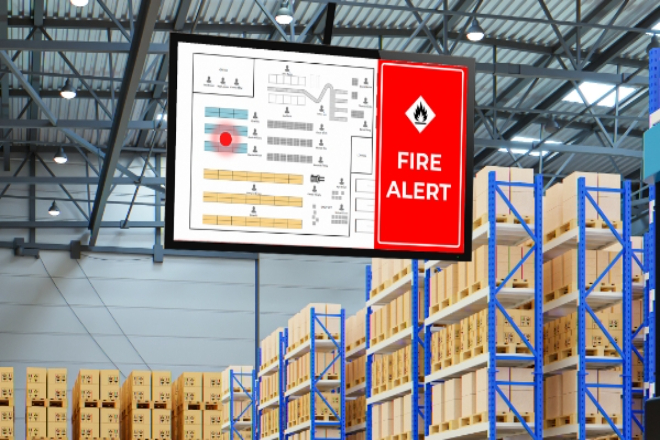
4). Smart warehousing
In smart warehousing, LED display screens are like “smart housekeepers” to help manage warehouses.
The warehouse is full of goods, and the LED screen can clearly show the location of each item, as well as the status of the goods, such as whether they are damaged or expired.
There are many automated equipment in the warehouse, such as robots and conveyor belts.
The LED screen can display the operating status of this equipment in real time. Once there is a problem with the equipment, it can be discovered and handled immediately.
The space in the warehouse is limited. The LED screen can display the use of storage resources, help managers arrange the storage of goods reasonably, and make the space utilization rate of the warehouse higher.
In short, LED display screens make management more efficient and resource utilization more reasonable in smart warehousing.
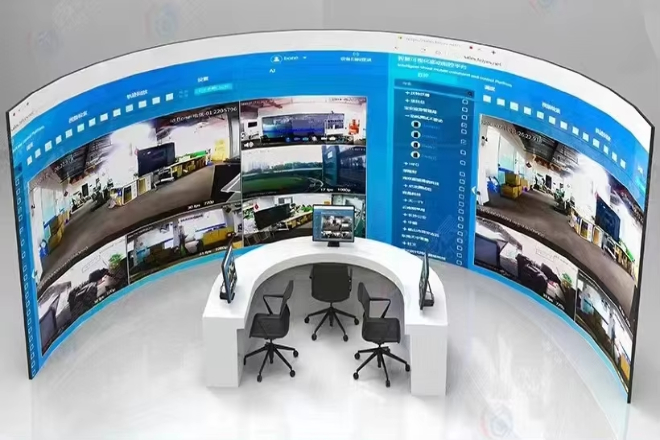
5). Logistics distribution center
The logistics distribution center is the “last mile” of the package, and the role of the LED display screen here is like an “express navigator.”
Customers are most concerned about where the package is. The LED screen can display the location and status of the package in real time so that customers can keep abreast of the dynamics at any time and feel at ease.
The delivery staff have to run to many places every day. The LED screen can display the optimized delivery route, so that the delivery staff can run less and improve efficiency.
The distribution center has to handle a lot of packages every day. The LED screen can clearly display the task allocation of each deliveryman, which is convenient for management personnel to dispatch and ensure that the packages can be delivered to customers on time.
In short, LED display screens make distribution more efficient and make customers more satisfied in logistics distribution centers.
4. Strategies for optimizing information display on LED display screens
1). Content optimization strategy
In smart logistics, there is a lot of information to be displayed on LED display screens. If it is piled up in a mess, it will not work.
Therefore, the most important information should be picked out first, such as the latest status of cargo transportation and emergency notifications, which should be displayed first.
Then, complex data should be displayed in a simple way, such as using bar charts, line charts, or small icons, so that people can understand it at a glance.
In addition, dynamic information (such as real-time updated vehicle location) and static information (such as operating instructions) should be well-matched so that the screen does not look too messy.
2). Display effect optimization strategy
If you want the LED display screen to look more comfortable, you have to work hard.
For example, you can use a split-screen display to display different types of information separately or multi-screen linkage to display information on multiple screens at the same time so that everyone can see it at a glance.
When switching between screens, don’t be too abrupt, use some smooth animation effects, so that it looks comfortable.
Also, according to different environments, such as indoors, outdoors, and whether the sunlight is strong or not, adjust the display mode to ensure that the information can be seen clearly in all situations.
3). System integration optimization strategy
LED display screens are not fighting alone, they must work closely with the logistics management system.
Just like two good friends, they must always keep in sync. Once the background data is updated, the information on the display screen must also change immediately.
Now, with the cloud platform, managers can remotely control the LED display screen and update the content no matter where they are, as long as there is a network, which is very convenient.
4). User experience optimization strategy
User experience is very important. The interface of the LED display screen should be designed to be simple and intuitive so that people can use it right away.
It can also allow users to adjust the displayed content and layout according to their needs.
For example, some users may be more concerned about the transportation status of the goods, while others may be more concerned about inventory information.
In addition, there must be a user feedback mechanism to listen to everyone’s opinions, see what is not done well, and make changes in time so that users can be more satisfied.
5). Reliability optimization strategy
If the LED display screen often breaks down, it will be troublesome.
Therefore, in terms of hardware, you should keep more “back-ups”, such as backup power supplies and backup display modules, so that if the main device breaks down, the backup can immediately take over.
In terms of software, there must be some “error resistance”, so that if there are some minor problems in data transmission or processing, the system can recover by itself or switch to the backup plan.
There must also be an early warning system to detect possible problems in advance and fix them in time to prevent the screen from being “black.”
In short, through these optimization strategies, LED displays can play a better role in smart logistics, which can not only make the information display clearer but also make users use it more smoothly.
5. Actual case analysis of LED display screens in smart logistics
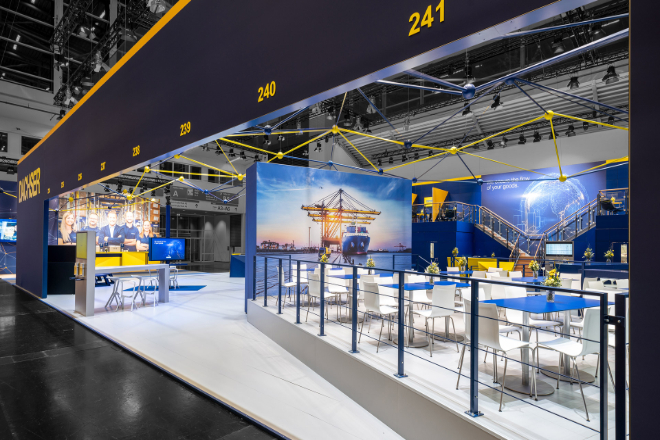
1). Dachser Logistics Center, Germany
Dachser Logistics Center, Germany, uses advanced LED display screen solutions at its Schönefeld base in Berlin-Brandenburg.
These LED screens are installed at key locations in the warehouse to display the storage location, transportation status and vehicle dispatch information of goods in real time.
Through seamless connection with the logistics management system, LED screens can dynamically update data to ensure that staff have the latest information at any time, thereby optimizing warehouse management and transportation dispatch efficiency.
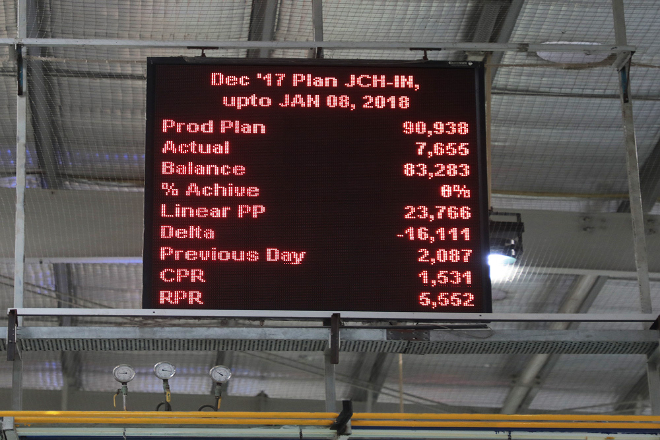
2). Lidl Logistics Center, Netherlands
Lidl Logistics Center, Netherlands, uses LED screens in its warehouse in Oosterhout.
These screens are not only used for real-time display of goods in and out of the warehouse, but also integrate information from multiple operation links in the warehouse, such as the operating status of automated equipment and inventory levels, through split-screen display and multi-screen linkage functions.
This integrated information display method significantly improves the management efficiency and transparency of the warehouse.
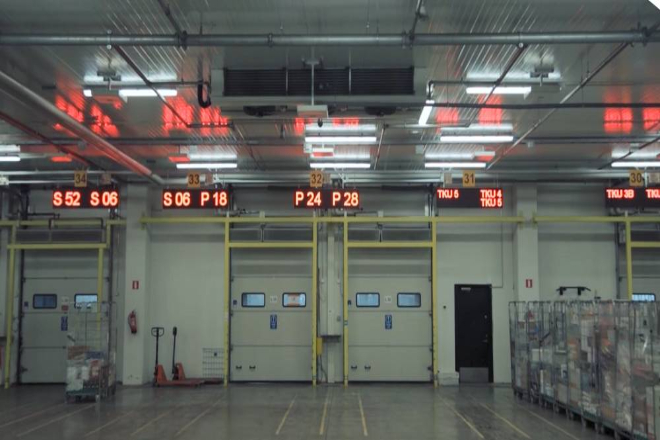
3). JD.com’s “Asia No. 1” fully automated warehouse
JD.com’s “Asia No. 1” warehouse is one of the world’s leading smart warehousing centers, in which LED screens are widely used.
These LED displays can not only update the storage location and status of goods in real time but also display the operation information of automated equipment, helping managers monitor the operation of the entire warehouse.
In addition, LED screens are also used to display task assignments and operation guides, further optimizing the management process of the warehouse.
6. Conclusión
Through this article, we have seen the powerful role of LED displays in smart logistics, which not only optimizes information display but also improves the efficiency and user experience of the entire logistics system.
From warehouses to transportation, from cold chains to distribution, LED displays are like ubiquitous “smart assistants,” bringing revolutionary changes to the logistics industry.
Finalmente, si quieres saber más sobre las pantallas LED, Por favor póngase en contacto con nosotros.
